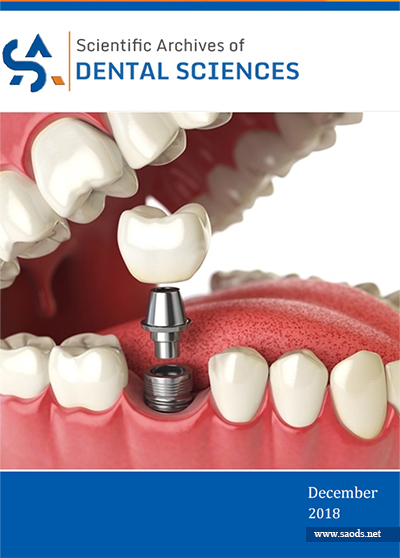News
SAODS – Volume 1 Issue 2

| Publisher | : | Scienticon LLC |
|---|---|---|
| Article Inpress | : | Volume 1 Issue 2 – 2018 |
| ISSN | : | 2642-1623 |
| Issue Release Date | : | December 01, 2018 |
| Frequency | : | Monthly |
| Language | : | English |
| Format | : | Online |
| Review | : | Double Blinded Peer Review |
| : | saods@scienticon.org |
Volume 1 Issue 2
Editorial
Volume 1 | Issue 2
Wael M Zakaria.
Success criteria of implant osseointegration included: no clinical mobility; no peri-implant radiolucency or infection; no complaints of pain, neuropathy, or paresthesia; and crestal bone loss that does not exceed 1.5 mm at the end of the first year of function or 0.2 mm per year subsequently. Several clinical evaluation methods were utilized to assess the implant‘s mobility as Percussion, Bi-digital, Reverse torque, Cutting torque resistance analysis (CRA) and Periotest.
Research Article
Volume 1 | Issue 2
John O Grippo and Michael J Spink.
The etiology and location of intra oral bony growths termed tori remains unclear and is considered a nonpathological exostoses. A clinical study of three patients having tori with evidence of parafunction for an extended period of time was conducted by (JOG). Diagnostic casts, clinical observations and patient’s history were used to monitor the enlargement of the tori at various intervals. Observations were that there was a significant relationship between the presence of both maxillary and mandibular tori to hyper – function and parafunctional activities. The common occurrence of tori in areas of greatest stress concentration, such as the hard palate’s midline suture and the lingual bicuspid/cuspid region of the mandible suggests that bone apposition may also be due to a piezoelectric effect which stimulates bone growth in these preferential locations. A hypothesis is presented based on established biomedical engineering mechanisms that stress concentration causes the formation and enlargement of tori.
Case Report
Volume 1 | Issue 2
Siddharth Mehta, Kanishk Gupta, Santhosh, Sonal and Surendra Lodha.
This article showcases multidisciplinary management of an extruded maxillary molar with gingival recession. Non-surgical peri – odontal and endodontic treatment were initiated. Micro implants were placed to intrude the molars. Periodontal surgery was then planned to cover the gingival recession, following which the tooth had a better prognosis.
Review Article
Volume 1 | Issue 2
Sanvritti Manjrekar.
Infections after surgical procedures can cause pain, poor wound healing, and increase the need for further treatment including antibiotics, longer hospital stays, and health care costs. Post-operative infections are a major cause of such increased mortality and morbidity around the world, especially in developing countries. Annually direct and indirect cost estimates of post-operative infections are more than $1 billion and $10 billion, respectively [1]. Often, major post-operative infections are reported as a surgical site infection (SSI) which has been defined by the CDC as an infection occurring within 30 days of an operative procedure or within one year in the event of implanting a device/material.
Review Article
Volume 1 | Issue 2
Mayara Santos de Castro and Marta Miyazawa.
This article aims to present important considerations and recommendations based on reviewed articles retrieved on PubMed database and guidelines for head and neck cancer patients for management and support before, during and after oncologic treatment, in order to maintain oral health, prevent, evaluate and treat side effects, improve quality of life and survival. Therefore, it is evident the vital importance of oral health providers for the oncologic treatment success of head and neck cancer patients.
Case Report
Volume 1 | Issue 2
Antonio Eugenio Magnabosco Neto, Beatriz Ferraz Magnabosco, Felipe Ferraz Magnabosco and Roberta Ferraz Magnabosco.
Objectives: To present a brief literature review and a case report involving an extreme involvement of periodontitis in patients with gestational risk, addressing clinical signs, inducing factors, treatment, and monitoring results.
Case Report: Patient TPF, 30 years old, female, leucoderma, carrier type I diabetes, pregnant with thirty-three-week gestational age, parturient for the second time, and not obese hypertensive, resident in the city of Joinville, home with 2nd degree full instruction. Admitted to the Emergency of a particular hospital in Joinville, in September 2013, with suspected ruptured membranes. After evaluation of the obstetrician assistant, dental clinic evaluation was requested due to the advanced stage of periodontitis.
Final considerations: After diagnosed periodontitis generally to reverse the situation, the trader should pay attention to the needs of the patient and the etiology of the disease. The planning stages of treatment based on a careful clinical examination, current and past medical history it is necessary to obtain success in treatment, as well as cooperation and self-care of patients with their oral hygiene. The periodontal infection in pregnant women may be a risk factor for the birth of premature infants with low birth weight.
Keywords: Periodontitis; High-Risk Pregnancy; Oral Hygiene
Case Report: Patient TPF, 30 years old, female, leucoderma, carrier type I diabetes, pregnant with thirty-three-week gestational age, parturient for the second time, and not obese hypertensive, resident in the city of Joinville, home with 2nd degree full instruction. Admitted to the Emergency of a particular hospital in Joinville, in September 2013, with suspected ruptured membranes. After evaluation of the obstetrician assistant, dental clinic evaluation was requested due to the advanced stage of periodontitis.
Final considerations: After diagnosed periodontitis generally to reverse the situation, the trader should pay attention to the needs of the patient and the etiology of the disease. The planning stages of treatment based on a careful clinical examination, current and past medical history it is necessary to obtain success in treatment, as well as cooperation and self-care of patients with their oral hygiene. The periodontal infection in pregnant women may be a risk factor for the birth of premature infants with low birth weight.
Keywords: Periodontitis; High-Risk Pregnancy; Oral Hygiene